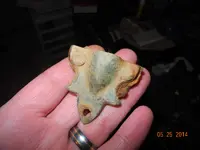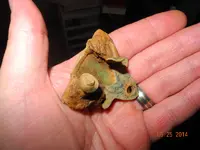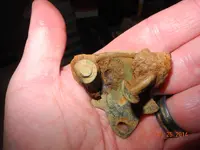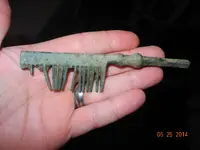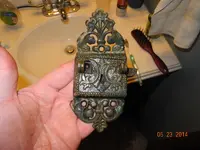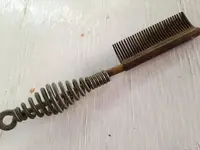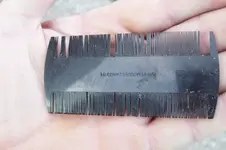You are using an out of date browser. It may not display this or other websites correctly.
You should upgrade or use an alternative browser.
You should upgrade or use an alternative browser.
Check these out
- Thread starter Rockhoppernc
- Start date
NOLA_Ken
Gold Member
- Joined
- Jan 4, 2011
- Messages
- 5,214
- Reaction score
- 4,179
- Golden Thread
- 0
- Location
- Formerly New Orleans.. Now Pueblo Co
- Detector(s) used
- several, mostly Garrett
- Primary Interest:
- All Treasure Hunting
I'd think more likely a decorative end for a leather strap based on the rivets. Third one is a really nice locking cabinet pull. I like it!
Upvote
0
G.I.B.
Gold Member
- Joined
- Feb 23, 2007
- Messages
- 7,187
- Reaction score
- 8,539
- Golden Thread
- 0
- Location
- North Central Florida
- 🏆 Honorable Mentions:
- 1
- Detector(s) used
- CTX 3030 / GTI 2500 / Infinium LS / Tesoro Sand Shark / 1 Garrett Pro-pointer / 1 Carrot / Vibra Probe 580 (out on loan) / Lesche M85 / Mark1 MOD1 EyeBall
- Primary Interest:
- Other
Toothbrush bathroom sink...yep been there done that, nice finds!
Looks like they use Pantene, probably has really nice smelling hair when digging up them great finds...
Great hunt- I don't know the history, but I like looking at the old stuff and wondering.
Upvote
0
Indian Steve
Silver Member
I think it is off of an old trunk. The lid has a couple of alignment "pins" that would fit into this part when the lid was closed. There usually two pins and two receiver pieces.
Upvote
0
TheCannonballGuy
Gold Member
- Joined
- Feb 24, 2006
- Messages
- 6,607
- Reaction score
- 13,455
- Golden Thread
- 0
- Location
- Occupied CSA (Richmond VA)
- Detector(s) used
- White's 6000, Nautilus DMC-1, Minelab
- Primary Interest:
- Relic Hunting
The thick brass "hair comb" was used in the late 1800s through early 1900s for "hot-curling" kinky hair.
Upvote
0
artemis moon
Hero Member
- Joined
- Jun 1, 2007
- Messages
- 873
- Reaction score
- 149
- Golden Thread
- 0
- Location
- Near Bangor, Maine
- Detector(s) used
- Minelab Safari
ProPointer
- Primary Interest:
- Metal Detecting
The thick brass "hair comb" was used in the late 1800s through early 1900s for "hot-curling" kinky hair.
That looks painful. I think if I lived in those days, I would have just lived with kinky hair :-)
Upvote
0
ivan salis
Platinum Member
- Joined
- Feb 5, 2007
- Messages
- 16,794
- Reaction score
- 3,812
- Golden Thread
- 0
- Location
- callahan,fl
- 🏆 Honorable Mentions:
- 1
- Detector(s) used
- delta 4000 / ace 250 - used BH and many others too
cannon ball guy --I have found 2 of those at known to me civil war era camp sites --both of them had a iron center thru wood handles ( one was rotted away both iron and wood --the other I found today had the iron centerpart intact with a loop on the end built in to hang it by) --the iron part was cast mated with the brass / bronze end -- I believe it because of its design that they had a outer wooden handle to hold it by -- it has wording stamped into it the first word is partial "--- marine medicine co." .. so could it be a lice 'hot comb' for killing lice ?--the teeth on it are curved not straight . or is it animal curry comb related -- both camp sites had horses --one was artillery , the other calvary.. based.
Last edited:
Upvote
0
TheCannonballGuy
Gold Member
- Joined
- Feb 24, 2006
- Messages
- 6,607
- Reaction score
- 13,455
- Golden Thread
- 0
- Location
- Occupied CSA (Richmond VA)
- Detector(s) used
- White's 6000, Nautilus DMC-1, Minelab
- Primary Interest:
- Relic Hunting
To be able to comment about them, I need to see photos of the two metal combs you found.
Meanwhile, here are educational links, with info and photos. It's not my intention to be argumentative... I'm just showing some of the research evidence for time-dating the hot-combs we dig. A wooden (or coiled-wire) handle protects the user's hand from the hot-comb's high heat. In particular, note the 1920 US Patent diagram at the first link. Second link shows one with a wooden handle (unfortunately the photo there doesn't allow copying). The third link shows one with "a loop at the end built in to hang it by" -- as you mentioned in your post. Both of the sellers say their hot-comb dates to the late-1800s.
Wikipedia article, with 1920 US Patent diagram:
Hot comb - Wikipedia, the free encyclopedia
Hot-comb with brass body and wooden handle, seller says late-1800s:
Vintage Brass Hot Pressing Comb - Marcel from amazinggrace on Ruby Lane
Hot-comb with coiled-wire handle, seller says late-1800s:
https://www.etsy.com/listing/151049040/antique-brass-hot-comb-vintage-hair
Meanwhile, here are educational links, with info and photos. It's not my intention to be argumentative... I'm just showing some of the research evidence for time-dating the hot-combs we dig. A wooden (or coiled-wire) handle protects the user's hand from the hot-comb's high heat. In particular, note the 1920 US Patent diagram at the first link. Second link shows one with a wooden handle (unfortunately the photo there doesn't allow copying). The third link shows one with "a loop at the end built in to hang it by" -- as you mentioned in your post. Both of the sellers say their hot-comb dates to the late-1800s.
Wikipedia article, with 1920 US Patent diagram:
Hot comb - Wikipedia, the free encyclopedia
Hot-comb with brass body and wooden handle, seller says late-1800s:
Vintage Brass Hot Pressing Comb - Marcel from amazinggrace on Ruby Lane
Hot-comb with coiled-wire handle, seller says late-1800s:
https://www.etsy.com/listing/151049040/antique-brass-hot-comb-vintage-hair
Attachments
Upvote
0
ivan salis
Platinum Member
- Joined
- Feb 5, 2007
- Messages
- 16,794
- Reaction score
- 3,812
- Golden Thread
- 0
- Location
- callahan,fl
- 🏆 Honorable Mentions:
- 1
- Detector(s) used
- delta 4000 / ace 250 - used BH and many others too
the item I found yesterday is similar to the wire handle model above * -- I can make out the wording "marine medicine co." stamped on it , ==the other one just has the brass part the iron center rod had rusted away at where it joins the brass at (no wording) and both were found at known civil war / Spanish American war used campsites (within a couple blocks of each other) --that had a large African American population afterwards living in the area..(there was a huge fire in 1901 that almost wiped out the entire town..of Jacksonville , Fl.) they say French models of this go back as far as the 1850's * and that sears and roebuck even had them in their catalogs in the 1880 time frame...( but I'm wondering why it was made by a "medicine co.?" I know that around the civil war era head lice was a horrible problem --could these "hot combs" hav been used to "fry lice and their eggs" in white folks hair ? thus used as a "medical tool" --anti lice comb?
Last edited:
Upvote
0
TheCannonballGuy
Gold Member
- Joined
- Feb 24, 2006
- Messages
- 6,607
- Reaction score
- 13,455
- Golden Thread
- 0
- Location
- Occupied CSA (Richmond VA)
- Detector(s) used
- White's 6000, Nautilus DMC-1, Minelab
- Primary Interest:
- Relic Hunting
Ivan, here are my thoughts in response to your questions.
Because lice are super-small bugs, a lice-comb needs to have VERY-FINE teeth to be effective at combing the lice out of human hair. (See the photo below.) Without seeing photos of the two metal combs you found, showing the size of the teeth on them, I can't say whether they are a lice-comb or a hot-comb.
Your theory that perhaps a hot-comb would be used to remove lice from hair is a reasonable-sounding one... but I think that if the metal comb was hot enough to sizzle the lice, it would also sizzle the hair.
I agree that it's "curious" that one of your metal combs is marked "Marine Medicine Co." I did a websearch for that name, to see if I could find info on that company's products, and its time-period... but I got no web results at all. Perhaps somebody else here will be able to find some historical information about that company.
As the Wikipedia article indicates, a hot-comb's purpose was to straighten kinky (or very-curly) hair. For anybody who doesn't already know... in the latter-1800s through early-1900s, hot-combs were popular with African-Americans who wanted to make their (naturally kinky) hair resemble the long smooth "flowing" hair of Caucasians ("White folks).
The photo below shows a lice-comb, made of "hard rubber," which was listed as being from the civil war era. However, I should mention (for anybody here who doesn't already know) that a patent-date on a relic only tells us the EARLIEST date that the relic was manufactured. The comb in the photo was made by the IR (India-Rubber) Comb Company... which was in business from 1852 to 1898. So, although the patent-date on that lice-comb is 1851, it could have been manufactured by the IR Comb Co. several years after the civil war ended (1865).
Because lice are super-small bugs, a lice-comb needs to have VERY-FINE teeth to be effective at combing the lice out of human hair. (See the photo below.) Without seeing photos of the two metal combs you found, showing the size of the teeth on them, I can't say whether they are a lice-comb or a hot-comb.
Your theory that perhaps a hot-comb would be used to remove lice from hair is a reasonable-sounding one... but I think that if the metal comb was hot enough to sizzle the lice, it would also sizzle the hair.
I agree that it's "curious" that one of your metal combs is marked "Marine Medicine Co." I did a websearch for that name, to see if I could find info on that company's products, and its time-period... but I got no web results at all. Perhaps somebody else here will be able to find some historical information about that company.
As the Wikipedia article indicates, a hot-comb's purpose was to straighten kinky (or very-curly) hair. For anybody who doesn't already know... in the latter-1800s through early-1900s, hot-combs were popular with African-Americans who wanted to make their (naturally kinky) hair resemble the long smooth "flowing" hair of Caucasians ("White folks).
The photo below shows a lice-comb, made of "hard rubber," which was listed as being from the civil war era. However, I should mention (for anybody here who doesn't already know) that a patent-date on a relic only tells us the EARLIEST date that the relic was manufactured. The comb in the photo was made by the IR (India-Rubber) Comb Company... which was in business from 1852 to 1898. So, although the patent-date on that lice-comb is 1851, it could have been manufactured by the IR Comb Co. several years after the civil war ended (1865).
Attachments
Upvote
0
ivan salis
Platinum Member
- Joined
- Feb 5, 2007
- Messages
- 16,794
- Reaction score
- 3,812
- Golden Thread
- 0
- Location
- callahan,fl
- 🏆 Honorable Mentions:
- 1
- Detector(s) used
- delta 4000 / ace 250 - used BH and many others too
context of the area found in area is important --if a item that was made in the civil war era as well as afterward * but is found in the woods where few if any folks would normally be at except for a campsite in my viewpoint it is ok to think most likely civil war --but if the area has high human traffic -- it might be or might not be "period"..
Last edited:
Upvote
0
Similar threads
- Replies
- 9
- Views
- 505
- Replies
- 7
- Views
- 1K
- Question
- Replies
- 2
- Views
- 460
Users who are viewing this thread
Total: 1 (members: 0, guests: 1)

